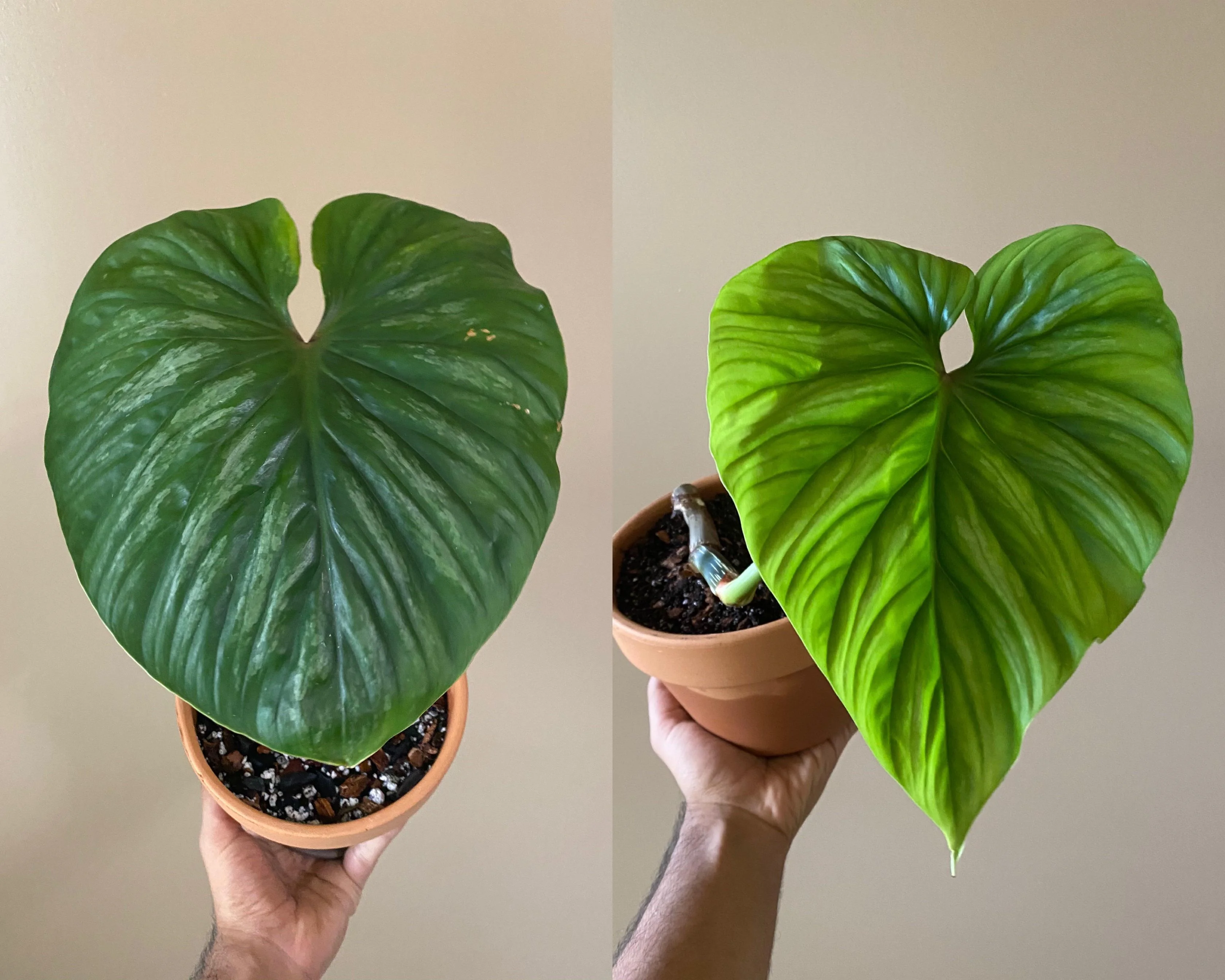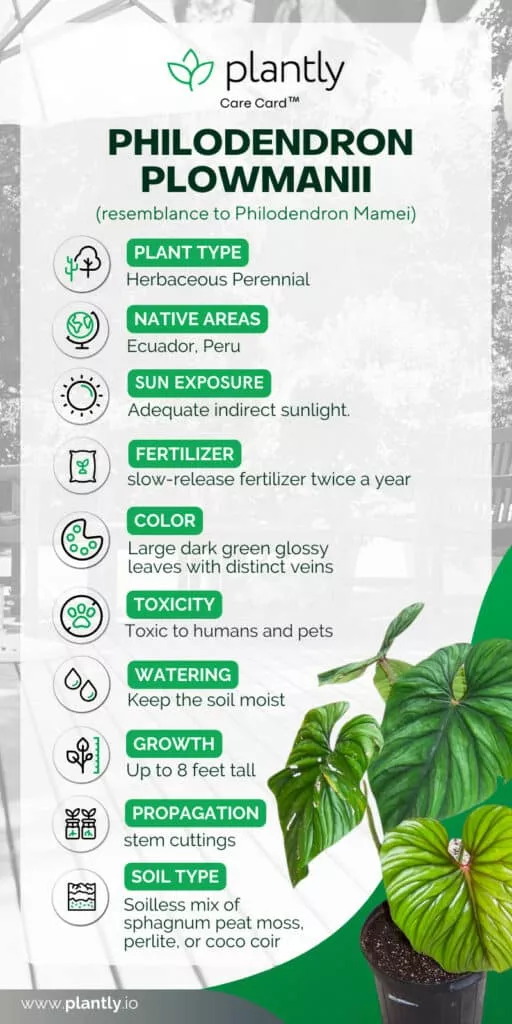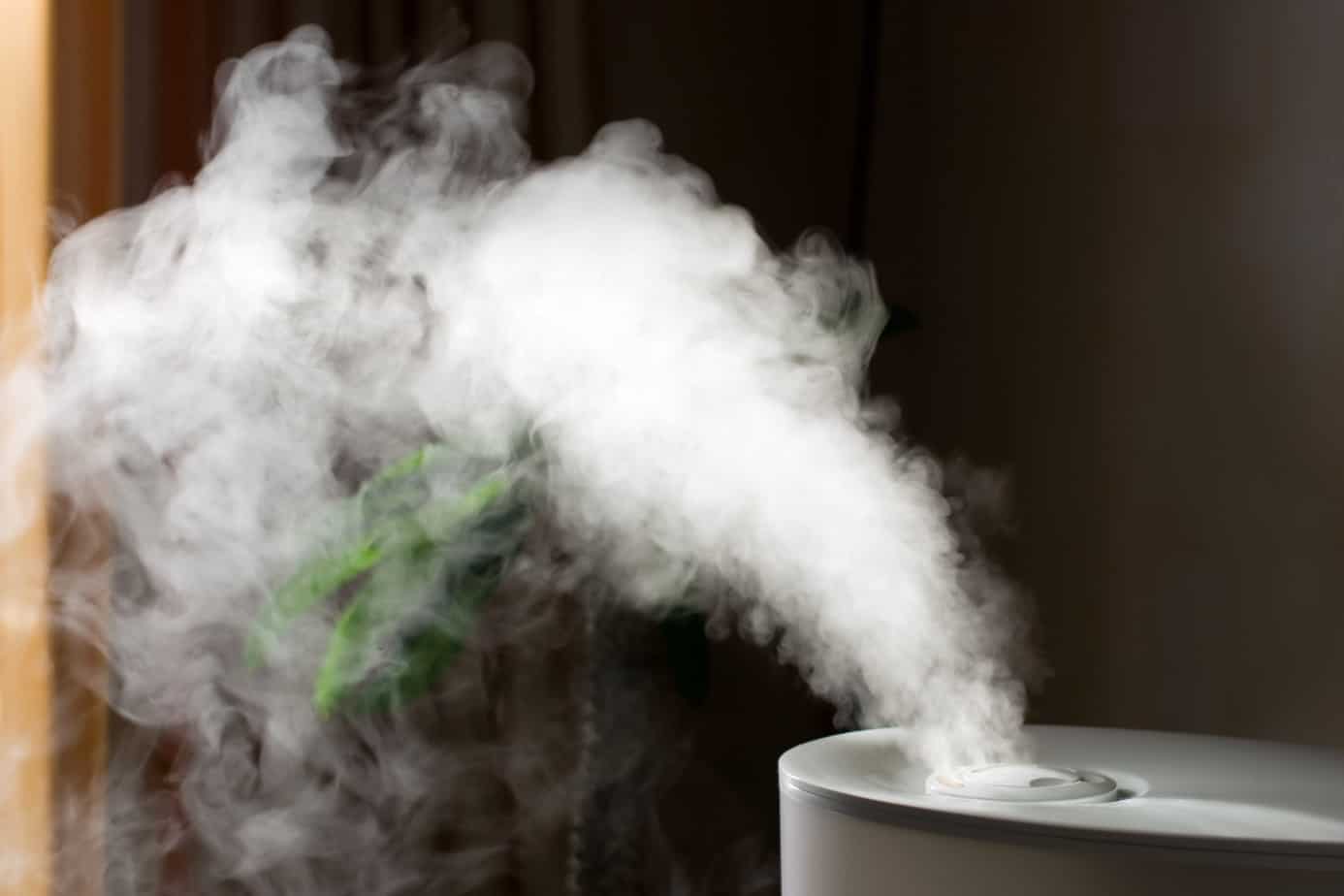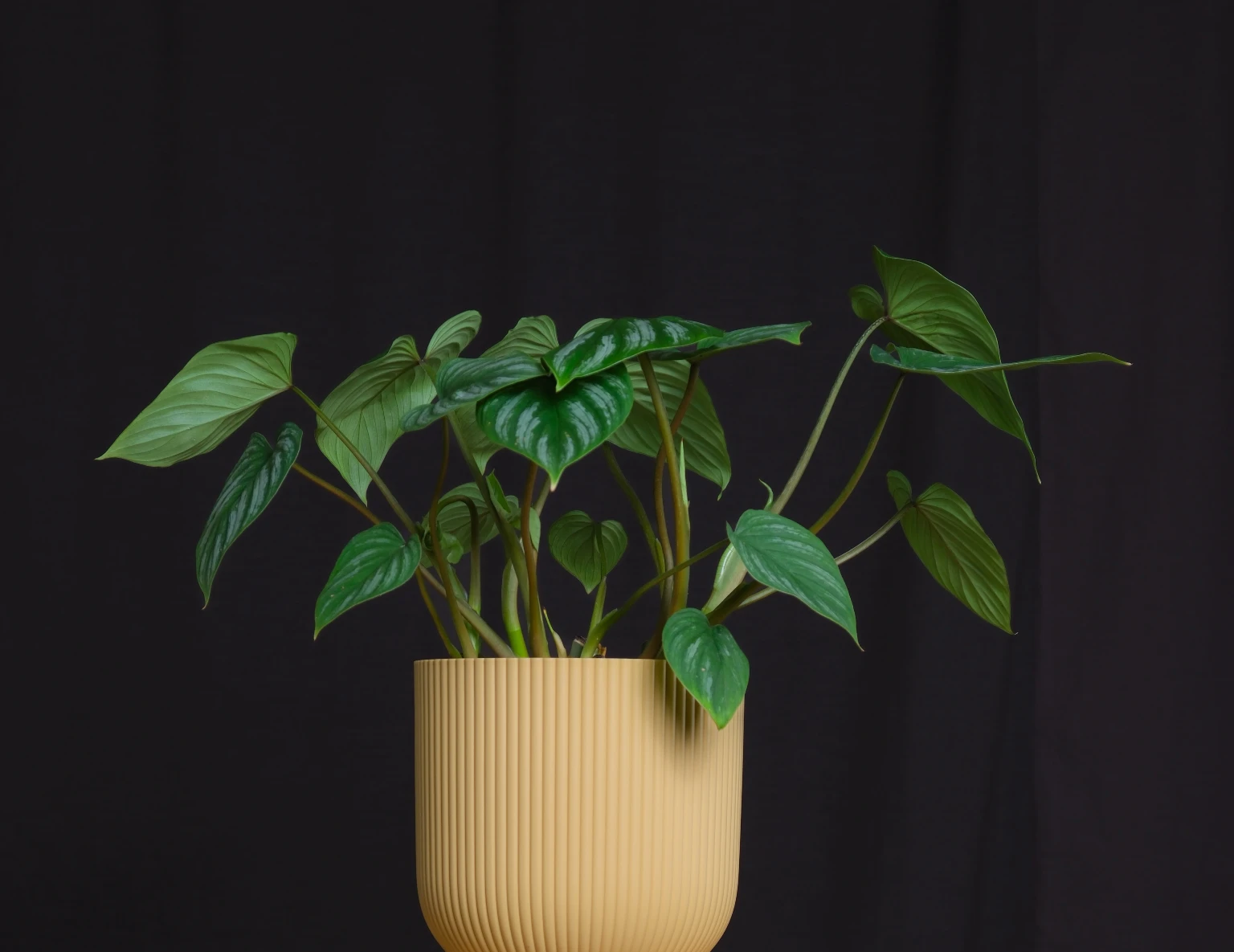No products in the cart.
Table of Contents
If you happen to adore broad-leaved plants in a gradient of colors, Philodendron Plowmanii may leave you utterly stunned. They are considered as one of the rarest Philodendrons and are undeniably a beautiful terrestrial treat!
What is Philodendron Plowmanii?

Philodendron plowmanii is a fascinating ovoid philodendron that originated from Ecuador and Peru. A member of the humungous plant family, Araceae, Plowmanni is named after the botanist Timothy Charles Plowman.
These tropical plants can grow up to 8 feet in height, thus you need to designate a generous space to accommodate them. Characterized by their massive leaves in multiple gradients of green contrasted with the creamy yellow venation.
The stem has an unusual habit, often referred to as “repent”, for it does not grow upright but rather moves around the ground. The stems have leaf nodes where a plant’s roots and petioles would usually form.
Philodendron Plowmanii Care

Philodendron Plowmanii plants can last you years before they need to be replaced. Whether you’re a professional gardener or a starting plant parent, know that to properly care for Philodendron plowmanii, you simply have to give them their required growing conditions, and of course, some TLC!
Ideal Potting Mix for Philodendron Plowmanii

The right potting soil is key for ensuring the optimum growth of most Philodendrons. And a soilless medium having a typical combination of sphagnum moss, peat moss, and perlite is the most preferable. Throw in some of that compost and you’ll create a rich soil that stays moist but doesn’t retain water.
As much as possible, try to avoid clay, sandy, and other wet soils which do not drain easily. Bear in mind that drainage is an important consideration when it comes to growing philodendron given their vulnerability to root rot.
Meanwhile, repotting philodendron plowmanii is only recommended for three reasons: First, the plant is growing slowly because it may be root bound, hence needed to be transferred to a larger container to give room for the roots to grow. Second, large plants are prone to outgrow their container and therefore must also be transferred to a much larger and bigger pot.
Lastly, if your philodendron plowmanii plant becomes infected with a disease, it may have to be removed from its pot while the salvageable parts must be transferred to a new and clean container.
Lighting Needs of Philodendron Plowmanii
Philodendron plowmanii prefers its surroundings with adequate indirect sunlight. When treated as an outdoor plant, a partial shade to full shade may be ideal. But to grow that large foliage, you can have this tropical plant placed in any spot that receives bright light.
Most Philodendron plants can easily survive in almost any light condition as long their delicate foliages are not hit directly by the direct sunlight as this may lead to scorching which can ultimately damage the plant.
Watering Philodendron Plowmanii
If there’s any major point to discuss here, it would be the Philodendron plowmanii’s water-loving characteristics. However, note that the watering needs of any houseplant certainly depend on the light and temperature that persists around them.
Philodendron plowmanii do love to thrive in moist soil and thus it is critical to water regularly. They are not a drought-tolerant species but they should not be overwatered as well.
Insufficient watering, as in most cases, retards the metabolic process in plants and thus leads to stunted growth. It may also cause irreversible wilting and yellowing of the leaves.
To check if it’s time for watering, feel the top two inches of the soil – and if it’s dry – begin watering thoroughly. As you reach the base of the plant, make sure that the excess water is drained. During the summer season, water once or twice a week. In winter, water the plant at least once a week.
Temperature and Humidity
Philodendron plowmanii ideally thrives in USDA hardiness zones 9b to 11 (25 °F (−3.9 °C) to +40 °F (4.4 °C). During summer, they can grace your patio. But as the winter season begins they must be immediately brought inside (under warm temperatures).

Compared to other members of the same genus, this tropical plant is humidity tolerant yet favors extra moisture of at least 60% or above. If you’re situated in regions with drier climates, you can easily maintain a fair level of ambient humidity by use of a humidifier or a much more frequent misting here and there.
Another proven method of increasing humidity at home is using a pebble tray. It’s also important to keep your philodendron plowmanii away from heating vents or air conditioners as this may be detrimental to the plant’s foliage.
Fertilizing Philodendron Plowmanii
Philodendron plowmanii are typically fed with a slow-release fertilizer twice or thrice a year. Complete fertilizers are usually applied at least 6 inches away from the base of the plant. Good quality liquid fertilizers may also be used, especially those of organic formulation.
Fertilizing is most recommended during the growing season, particularly in spring and summer. This will speed up the development of growing plants, especially for a plant considered a slow grower.

Avoid using low-quality fertilizers and tune in to using compost or vermicasts as amendments to encourage good bacteria – as this can also mimic the natural environment in which they thrive.
Philodendron Plowmanii Propagation
The use of stem cuttings is one of the most common methods of propagating philodendron plowmanii. After sanitizing and preparing your tools, carefully take the stem cuttings at least 2 to 3 inches long using a sterile knife. Make sure that each of the propagules has at least 1-2 leaves on them.
You do either allow the cuttings to sit in a glass jar, submerging the bare nodes in water (just be sure that the water is not touching the leaves), or do the soil propagation technique, where the cuttings are placed on a slightly acidic soil medium.
Having planted in soil, cover the pot with plastic to mimic a greenhouse environment. Poke some small holes in the plastics for proper air circulation.
Be sure to keep the water moisturized. Most roots grow under filtered light and moderate temperatures. Look for signs of root development within 3-4 weeks and once it’s ready, you may transfer the plant to your preferred container. All the while observing proper care.
Philodendron Plowmanii Varieties
Below are gorgeous philodendron varieties similar to Plowmanii.
Philodendron mamei

Philodendron plowmanii is often mistaken for Philodendron mamei due to their close resemblance. But the major difference you may have to pay attention to is through their foliage because the mamei tends to have silver variegation while the plowmanii plant does not. You may also notice that the philodendron plowmanii has ruffled petiole edges.
Nevertheless, both philodendron species are in demand worldwide and offer equally stunning foliage!
Philodendron Dark Lord
The highly regarded foliage of this philodendron begins deep orange to blood-red which can also transition to a deep dark green top complimented by its metallic maroon underside.
This rare-find plant also loves a warm location with bright indirect light. Certainly a must-have for big leaf collectors!
Philodendron Pastazanum
Although both the philodendron plowmanii and pastazanum have heart-shaped leaves, the plowmanii plant has a much darker shade as well as venation. The pastazanum is light-colored and has an almost white venation. However, both are mainly found crawling on grounds of most tropical rainforests.
Pastazanum has extremely gorgeous heart-shaped leaves that would certainly fit any tropical garden. What’s the story behind the name? The plant originated from Ecuador in a state called Pastaza where it was collected in the ’70s.
Philodendron Plowmanii Diseases and Pests
Early diagnosis leads to early recovery, and this is also true for plants. The followings are the most common diseases of philodendron plowmanii and some of the ways you can treat them:
Pseudomonas and Xanthomonas leaf spot
Pseudomonas leaf spot or bacterial leaf spot causes the formation of “reddish” brown spots that may even make the leaves and stem appear distorted. When infected, the leaves develop watery, yellow lesions and then eventually start to droop. These symptoms are either caused by bacteria or fungus that may have gained access through wounds.
Once the symptoms are observed, immediately prune the infected plant part and water the plant from underneath as damp conditions on the leaf surface encourage fungal growth. Also, try to maintain temperatures of about 70 °F and humidity levels at 65%.
Erwinia blight
Erwinia blight is of the common occurrence of philodendron species. It is usually caused by certain defects in management such as temperature extremes, planting too deep in the pot, overwatering of the plant, or too much use of nitrogen fertilizer.
Unfortunately, there are currently no chemical means of treating Erwinia, but proper care paired with cultural management may help prevent the occurrence of the disease.
Aphids
Aphids can infect several plants in your garden as they can easily travel from one plant to another. As they feed on your plant, they excrete honeydew that can lead to the proliferation of other insect pests. If remain untreated, they can cause stunted growth and curling as well as yellowing of the foliage.
Frequently Asked Questions
The Philodendron plowmanii plant is a creeper and is often found growing along the ground of most rainforests in many tropical areas of South America.
A healthy philodendron has a well-established root system, vibrant bicolor heart-shaped leaves, and eventually grows taller in time.
Mix in the usual fertilizer you use with your garden soil and use this as a potting medium for your Philodendron plowmanii plant. This encourages favorable and faster growth provided that there is adequate sunlight and water.
The Philodendron plowmanii variegated may look intimidating for new plant parents but worry not because Plantly is here to guide you every step of the way!
Whether you want to buy, sell or simply reach out to other plant enthusiasts, Plantly is the right place to be!


